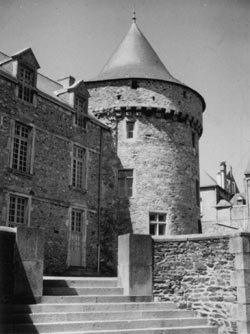 Recruits for Montréal...
Recruits for Montréal...
In 1641, a meeting took place between M. Jerome de Royer, Sieur de la Dauversière, who was receiver-general of taxes at LaFlêche, Anjou, France, and Paul de Chomeday, Sieur de Maisonneuve, a soldier and only son of an old and wealthy family. They were both members of the Société de Notre Dame de Montréal, a society founded in France in 1640 to establish a foothold in Canada and convert the Indians to Christianity. Shortly after the 1641 meeting, Maisonneuve was appointed governor of New France with the authority to collect equipment and stores and to aid in selecting volunteers.
Maisonneuve left from La Rochelle in 1641, and after a difficult crossing arrived in Quebec City where the group spent the winter there. There the governor of Québec, Charles de Montmagny, attempted to dissuade the missionaries and Maisonneuve warning them of the danger of a settlement in the heart of Iroquois territory. Maisonneuve scoffed at the dangers and the next May, he and the colonists left for the Montreal Island.
In May 1642, Maisonneuve arrived at Pointe à Callières, a spit of land in Villemarie (Montréal), along with two governors, staff officers, a number of Jesuit priests, Madame de la Peltrie, Jeanne Mance, and a few others -- 21 in all. Among them they had raised seventy-five thousand livres in France for the project. They immediately set about building a fort. By the end of 1642, there were 70 people living in Villemarie. In January 1644, Villemarie's population was down to 60 occupants. There were constant attacks by the Iroquois. Settlers arrived in dribs and drabs. The Iroquois kept everyone in a state a fright. By the 1650s, the on-going attacks had sapped the will of even the missionaries. But, Maisonneuve was determined.
In 1653, after two years of recruitment in France, 154 men had signed contracts to work at Villemarie. Only 120 of them showed up for the sailing from St. Nazaire in Brittany. The ship, St. Nicolas de Nantes, commanded by Captain Pierre le Besson, awaited them, and they left port 6-20-1653, destination Montréal. On board would be 15 filles à marier.
As soon as the anchor was raised, it was apparent the ship was rotten and water appeared everywhere. By the time the ship was 350 leagues at sea, it was fround to be so unseaworthy that it returned to port and another ship had to be chartered. It proved to be difficult to find another ship on such a short notice. Because of the fanfare, the actual departure from France was delayed until the 20th of July. To add to the miseries of this trip, which eventually took the lives of eight of the passengers.
The voyage ended around the 21st of September when the vessel arrived in Québec. The passengers destined for Montréal didn't arrive there until 11-16-1653. The ship which had run aground at Québec, and was springing new leaks, was burned in the river.
A second recruit in 1659 was made by the Society of Notre Dame to bring settlers Montréal. At this time, they brought over a sizeable group of families, servants and single women. They sailed on the ship Saint André.
Montréal would survive.
*
Six male ancestors and three young women ancestors sailed on the St. Nicolas de Nantes. They are Julien Daubigeon and his wife, Perinne Meunier, Louis Guertin, cousins, Mathurin Langevin and Jean Valiquet, Jean LeMarché, Michel Messier, Jeanne Soldé and Marie Renault who would become the wife of Mathurin Langevin in October 1654.
